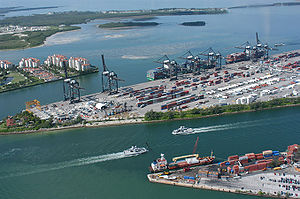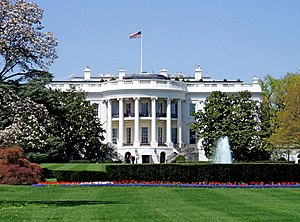Civil Engineer and Inventor John Hillman Named by White House as Transportation Champion of Change
May 8th, 2013 | By: America's Infrastructure Report Card
 Imagine holding four U.S. patents for a landmark and unique bridge technology, more than a dozen foreign or pending patents and winning every major design and construction award available in the nation. Now imagine all of this being accomplished by one individual – civil engineer John Hillman.
In a White House ceremony today, Hillman and 10 other notable individuals were recognized as Transportation Champions of Change for their exemplary work and leadership in developing and implementing transportation technology solutions to enhance performance, reduce congestion, improve safety and facilitate communication across the transportation industry at the local, state and national levels.
A structural engineer with more than 27 years of experience, Hillman’s more noteworthy achievements include managing the construction of a 1,263-foot incrementally launched bridge in Puerto Rico and the design and management of the award-winning 35th Street pedestrian bridge over Lake Shore Drive in Chicago, Ill. He has also been the engineer of record for almost every type of bridge structure imaginable, including a cable-stay, an arch, a truss and a suspension bridge, as well as numerous conventional structures.
Despite an impressive array of world-class bridge designs, Hillman’s crowning achievement is the invention of the Hybrid-Composite Beam (HCB®), a new type of structural beam developed for use in bridges and other structures. This unique technology is a tied arch of concrete and steel contained in a composite shell that optimizes the structural performance of each material in the composition. What results is an economical structural beam for railroads, highways and marine structures that offers a service life of more than 100 years.
The HCB provides for an economical application of advanced composites in infrastructure bridge technology, resulting in bridges that are stronger, safer, lighter, faster to install and much more sustainable than conventional bridge technologies. To date, 24 HCB bridges have been constructed in seven different states, with many more in various stages of planning, design and construction.
According to Hillman, he became a civil engineer because he loves building things. He said he gravitated towards bridges because literally and figuratively he gets to help people stay connected.
Hillman’s goal with the invention and development of the HCB is to provide a revolutionary bridge technology that not only remedies the state of the nation’s decaying bridges, but also provides a solution to the problem that will reduce the burden of infrastructure rehabilitation costs for future generations.
Here’s a video about other Champions of Change featuring an ASCE Past President, Kathy Caldwell.
Imagine holding four U.S. patents for a landmark and unique bridge technology, more than a dozen foreign or pending patents and winning every major design and construction award available in the nation. Now imagine all of this being accomplished by one individual – civil engineer John Hillman.
In a White House ceremony today, Hillman and 10 other notable individuals were recognized as Transportation Champions of Change for their exemplary work and leadership in developing and implementing transportation technology solutions to enhance performance, reduce congestion, improve safety and facilitate communication across the transportation industry at the local, state and national levels.
A structural engineer with more than 27 years of experience, Hillman’s more noteworthy achievements include managing the construction of a 1,263-foot incrementally launched bridge in Puerto Rico and the design and management of the award-winning 35th Street pedestrian bridge over Lake Shore Drive in Chicago, Ill. He has also been the engineer of record for almost every type of bridge structure imaginable, including a cable-stay, an arch, a truss and a suspension bridge, as well as numerous conventional structures.
Despite an impressive array of world-class bridge designs, Hillman’s crowning achievement is the invention of the Hybrid-Composite Beam (HCB®), a new type of structural beam developed for use in bridges and other structures. This unique technology is a tied arch of concrete and steel contained in a composite shell that optimizes the structural performance of each material in the composition. What results is an economical structural beam for railroads, highways and marine structures that offers a service life of more than 100 years.
The HCB provides for an economical application of advanced composites in infrastructure bridge technology, resulting in bridges that are stronger, safer, lighter, faster to install and much more sustainable than conventional bridge technologies. To date, 24 HCB bridges have been constructed in seven different states, with many more in various stages of planning, design and construction.
According to Hillman, he became a civil engineer because he loves building things. He said he gravitated towards bridges because literally and figuratively he gets to help people stay connected.
Hillman’s goal with the invention and development of the HCB is to provide a revolutionary bridge technology that not only remedies the state of the nation’s decaying bridges, but also provides a solution to the problem that will reduce the burden of infrastructure rehabilitation costs for future generations.
Here’s a video about other Champions of Change featuring an ASCE Past President, Kathy Caldwell.
Senate to Take Up Water Resources Development Act (WRDA)
May 6th, 2013 | By: America's Infrastructure Report Card
The Senate is expected to take up the Water Resources Development Act (WRDA) when Senators return to Washington today. At this time, Majority Leader Harry Reid (D-NV) has said that he will hold a cloture vote on the legislation Monday evening. Cloture requires 60 votes and limits debate in order to block an attempt at a filibuster. ASCE strongly urges the Senate to take up and pass S.601, the Water Resources Development Act (WRDA) of 2013. ASCE’s 2013 Report Card for America’s Infrastructure graded the nation’s ports a “C”, inland waterways a “D-”, dams a “D”, and levees a “D-”. Our nation’s water resources infrastructure is critical to our economy, public safety, and the preservation and enhancement of our environmental resources. In fact, ASCE’s Failure to Act economic study on the nation’s marine ports and inland waterways shows that underinvesting in just these two sectors threatens more than 1 million U.S. jobs and $270 billion in U.S. exports by 2020. The current Senate bill makes a strong commitment to our nation’s critical water resources infrastructure and ASCE strongly supports language that:- Creates a National Levee Safety Program;
- Reauthorizes the National Dam Safety Program;
- Restores trust to the Harbor Maintenance Trust Fund;
- Creates a new Water Infrastructure Finance Innovations Authority (WIFIA); and
- Streamlines the project approval process for water resources projects.
Tags: congress, dams, infrastructure, ports, senate, water resources development act
No Comments »
ASCE Statement on the Nomination of Mayor Anthony Foxx for Transportation Secretary
April 29th, 2013 | By: America's Infrastructure Report Card
WASHINGTON, D.C. – The following is a statement from Gregory E. DiLoreto, P.E., P.L.S, D.WRE, president of The American Society of Civil Engineers (ASCE), regarding the nomination of Charlotte Mayor Anthony Foxx for U.S. Transportation Secretary:
“We are very encouraged by Mayor Foxx’s nomination. Now is the time to reaffirm our commitment to improving our nation’s infrastructure and building a 21stcentury
Anthony Foxx, Democrat, mayor of Charlotte, North Carolina. Taken during his 2009 campaign for mayor. (Photo credit: Wikipedia)
###
Founded in 1852, the American Society of Civil Engineers represents more than 140,000 civil engineers worldwide and is America’s oldest national engineering society. For more information, visit www.asce.org.Obama FY14 Budget Proposal Focuses on Infrastructure
April 12th, 2013 | By: America's Infrastructure Report Card
President Obama released a federal budget plan for Fiscal Year 2014 this week that calls for spending of $3.77 trillion. The budget plan would reduce the federal deficit by $1.8 trillion over 10 years, the White House said. The FY 2014 budget proposal includes $50 billion for infrastructure investments, including $40 billion to cover what are called “Fix it First” projects; to invest in repairing highways, bridges, transit systems, and airports nationwide; and to provide $10 billion for competitive programs to encourage innovation in completing high-value infrastructure projects. “The budget invests in repairing our existing infrastructure and building the infrastructure of tomorrow, including high-speed rail, high-tech schools, and power grids that are resilient to future extreme conditions,” the White House added. “These investments will both lay the foundation for long-term economic growth and put workers back on the job now.” The president’s budget would reduce spending on other infrastructure, including programs designed to finance improvements to wastewater and drinking-water systems. The budget also seeks to restructure the current Highway Trust Fund by renaming it the Transportation Trust Fund and adding a dedicated funding source for rail. In regards to the Highway Trust Fund solvency, the budget proposes transferring $214 billion over six years to handle the issue and pay for increased outlays in the transportation bill after MAP-21 expires. This could set up the next reauthorization with funding levels 25% higher than its predecessor. However, there is no indication of how the expanded Trust Fund would remain solvent for the long term. The budget plan also includes $40 billion for rail over the next five years, focused on creating new corridors and improving current networks, including Amtrak. As part of the changes, the budget once again proposes to move Amtrak out from under the annual appropriations cycle and instead allow it to receive grants from the new transportation trust fund. For fiscal 2014, Amtrak would receive $2.7 billion, a large increase over last year’s $1.3 billion appropriation. The budget would also allocate $6.6 billion to the Federal Rail Administration, a large increase from the $1.7 billion it received in fiscal 2012. The Federal Aviation Administration would see a small increase under the FY 14 proposal with the President proposing $16.4 billion versus the $15.8 billion enacted last year. However, the capital grants program sees a cut in the Obama proposal with $2.9 billion for the Airport Improvement Program, compared with the $3.4 billion it received in FY13. To account for the cuts, large hub airports would be able to increase the non-federal Passenger Facility Charge; however there is no language on how much these fees can or should be increased. In a statement this week, ASCE Presdient Gregory E. DiLoreto, P.E., P.L.S, D.WRE, praised the 2014 budget proposal and its focus on investing in America’s transportation infrastructure: “The American Society of Civil Engineers applauds President Obama’s continued push for robust transportation funding, including $50 billion in immediate investments to address highway repair and construction, airports, rail projects and other transportation initiatives. “While this proposal certainly is a step in the right direction to bolster investment levels in transportation, it’s critical that the administration put forth a clear road map with long-term funding solutions. “In the 2013 Report Card for America’s Infrastructure, we awarded our country a D+. Transit, roads and aviation all received a dismal grade of D. These grades are unacceptable for our nation and must be backed by dedicated funding sources and innovative solutions at all levels of government if we hope to see improvements. “It’s time for all leaders from all parties to invest in America’s future to assure we have a strong foundation for an ever-changing 21st century economy.”The Panama Canal Expansion and Commerce
April 10th, 2013 | By: America's Infrastructure Report Card
The Senate Commerce, Science, and Transportation Committee held a hearing this afternoon on the expansion of the Panama Canal and the effects that the expansion will have on freight movement in the United States. The issue is one that ASCE has been discussing in depth over the past few months, because the economic impacts could be severe. During the hearing Chairman Jay Rockefeller strongly stated that the United States has “grown accustomed to an ad-hoc approach to maintaining our surface transportation network”. He went on further to state that “this lack of planning and shortsighted thinking doesn’t reflect what our country truly needs: A strategic, long-term vision for rebuilding our transportation system.” Rockefeller finished his opening remarks declaring that without a vision and the ability to make tough choices, that the U.S. will end up burdened with “inadequate infrastructure” as the rest of the world continues investing. With the scheduled expansion of the Panama Canal by 2015, the average size of container ships is likely to increase significantly, affecting the operations at most of the major U.S. ports that handle containerized cargo and requiring both sectors to modernize. Needed investment in marine ports includes harbor and channel dredging, while inland waterways require new or rehabilitated lock and dam facilities. To remain competitive on a global scale, U.S. marine ports and inland waterways will require investment in the coming decades beyond the $14.4 billion currently expected. ASCE reports that with an additional investment of $15.8 billion between now and 2020, the U.S. can eliminate this drag on economic growth and protect:- $270 billion in U.S. exports
- $697 billion in GDP
- 738,000 jobs in 2020
- $872 billion in personal income, or $770 per year for households
Obama Expands on Infrastructure Plans
April 8th, 2013 | By: America's Infrastructure Report Card
President Obama used ASCE’s 2013 Report Card for America’s Infrastructure several weeks ago at the Port of Miami to make a renewed push for increased infrastructure investment. The President has been pushing for a more complete set of infrastructure proposals for years and even included the message in his State of the Union this past January. The Obama Administration’s latest proposal includes:- A $10 billion infrastructure bank focused on national and regional significance, headed by an independent, bipartisan board.
- America Fast Forward bonds, which would build off the success of Build America Bonds. The bonds would be structured to benefit investors, including pension funds that do not benefit from traditional tax-exempt debt, but the administration says its proposal is close to being revenue-neutral.
- An increase in the cap on certain private activity bonds. In particular, no cap on the amount issued for water projects and a $4 billion increase up to $19 billion for highway and freight facilities. The bonds could also be used for privately owned airports, port facilities, and mass-transit commuting facilities.
- A plan to make foreign pension plans tax exempt for infrastructure and other real property assets. Gains on those investments are now taxable at a 35 percent rate, while domestic pension funds are exempt from such taxes. As a result, big pension funds are not investing in the United States according to the administration.
- An additional $4 billion injection into TIGER grants and the TIFIA (Transportation Infrastructure Finance and Innovation Act) program in FY 2014. Transportation Investment Generating Economic Recovery (TIGER) grant funds were already expanded by MAP-21.
House and Senate Pass Budget Resolutions for 2014
April 2nd, 2013 | By: America's Infrastructure Report Card
The Senate passed a budget resolution for the first time in four years on March 23 that calls for reducing the federal deficit by $1.85 trillion over 10 years. The Senate also approved provisions in the resolution for Fiscal year 2014 that would restore the $85 billion cut from the Fiscal Year 2013 budget under the sequestration order issued by the White House this month. After 13 hours of voting on various amendments and early-morning deal brokering in response to frustrated Republicans, the Senate voted to pass the budget by a close 50-49 vote. The resolution is not legally binding but only serves as a guide to the Senate Appropriations Committee, which must begin writing legislation to fund federal agencies for the fiscal year beginning October 1, 2013. Keeping in line with earlier draft language, Senate Budget Chairwoman Patty Murray (D-WA) was able to retain a $100 billion jobs and infrastructure package in the fiscal 2014 budget, which includes a $50 billion infusion to fix the nation’s most deficient bridges, airports and transit systems, keeping in line with President Obama’s fix it first concept for infrastructure investment. “The Senate budget tackles our deficit and debt the way the American people have told us they want it done: with a balanced mix of responsible spending cuts and new revenue from the wealthiest Americans and biggest corporations,” the budget document said. The House passed Rep. Paul Ryan’s (R-WI) budget earlier in March. The budget passed with a vote of 221-207. Instead of calling for an overhaul in how we fund infrastructure, the Ryan budget intends for the federal government to only spend what the gas tax brings in rather than continue to supplement the Highway Trust Fund with general fund transfers. This direction would effectively cut about a third of federal government spending on surface transportation. Currently, the gap between what gets spent out of the Highway Trust Fund and what the trust fund brings in is around $15 billion a year. The House budget also identifies the U.S. Department of Transportation as a department that offers “a number of areas where spending could be cut back responsibly.” It goes on further to state that the federal formula for spending on surface transportation is “distorted, leading to imprudent, irresponsible and often downright wasteful spending.” The House Budget Resolution can be seen here. The Senate Budget Resolution can be seen here.Vermont Section Supporting Transportation Funding Plan
March 15th, 2013 | By: America's Infrastructure Report Card
ASCE’s Vermont Section has been active over the last week in support of a proposed transportation funding plan that includes an increase in the state’s gas tax. The Section sent a letter last week to the Governor, legislative leaders and members of the House and Senate Transportation Committees in support. Additionally, ASCE has issued a key alert on the proposal, asking members to contact legislators in support of the proposal. The $32 million revenue package was approved this week by the House Transportation Committee by a 10-0 vote. The bill moves next to the House Ways and Means Committee, which reviews all tax proposals. Read more: Burlington Free Press 3/13/13Tags: infrastructure, legislation, transportation
No Comments »
Obama Expands On Infrastructure Proposals
February 25th, 2013 | By: America's Infrastructure Report Card
President Obama last week provided more detailson his infrastructure plans that were first mentioned during the State of the Union address. The administration released a fact sheet that offers some specifics, however many of the details will still have to wait until the President releases his budget proposal in a few weeks. The announcement this week focused on three items: A “fix-it-first” proposal to repair existing infrastructure before building new projects, a “Rebuild America Partnership” to bring private money off the sidelines through a new bond program, and a continued “modernization effort” to speed up permitting and construction. The President’s plan would immediately invest $50 billion in our nation’s transportation infrastructure, with $40 billion targeted to the most urgent upgrades and focused on fixing our highways, bridges, transit systems, and airports most in need of repair. However, the President’s proposal does not outline a funding source for this infusion. In the past, Obama has said his infrastructure proposals could be paid for by using savings from winding down wars overseas, but that has not been specifically mentioned this time around. We applaud the President for focusing on infrastructure investments and looks forward to working with the administration and Congress on how we can make these much needed investments. We are also hopeful that a long-term funding plan for surface transportation can be implemented that averts insolvency of the Highway Trust Fund.Tags: congress, economics, highway trust fund, infrastructure, infrastructure investment, state of the union address
No Comments »



 */ ?>
*/ ?>























